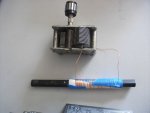PROXIMA-CENTAURI-B
Member
- Joined
- Mar 10, 2022
- Messages
- 14
Hello my friends. The pic below shows my software defined radio. It can tune from 500 kHz to 1.7 GHz.
It comes with a telescopic dipole antenna that is also shown below. The telescopic dipole antenna is 6.5 feet from tip to tip while they have an angle of 180 degrees between them.
1) A person on YT, said that every antenna length needs to be tuned to the frequency it is receiving. This means, the actual length of the antenna needs to change based on the receiving frequency. (
)
2) Assuming the person is correct, does it mean that I have to adjust my telescopic antenna length based on what frequency I am trying to receive?
3) My software defined radio can receive a 1000KHz station. That would mean, my antenna needs to be 299.80 meters long. ( Wavelength of 1000KHz is 299.80 meters ) But my antenna is only 6.5 feet long. Why am I still able to receive the 1000KHz station?
4) Assume, I am trying to receive a 327.85MHz signal. ( 327.85MHz has 0.9144 meters wavelength ) Am I supposed to reduce the length of my telescopic dipole antenna, such that it measures just 0.9144 meters, from tip to tip with 180 degrees between them?
My friends, to make a long story short.....if antenna tuning and the antenna length are very important, then why are we not required to adjust the antenna length everytime we change reception frequencies?
Thank you for the information my friends!


It comes with a telescopic dipole antenna that is also shown below. The telescopic dipole antenna is 6.5 feet from tip to tip while they have an angle of 180 degrees between them.
1) A person on YT, said that every antenna length needs to be tuned to the frequency it is receiving. This means, the actual length of the antenna needs to change based on the receiving frequency. (
2) Assuming the person is correct, does it mean that I have to adjust my telescopic antenna length based on what frequency I am trying to receive?
3) My software defined radio can receive a 1000KHz station. That would mean, my antenna needs to be 299.80 meters long. ( Wavelength of 1000KHz is 299.80 meters ) But my antenna is only 6.5 feet long. Why am I still able to receive the 1000KHz station?
4) Assume, I am trying to receive a 327.85MHz signal. ( 327.85MHz has 0.9144 meters wavelength ) Am I supposed to reduce the length of my telescopic dipole antenna, such that it measures just 0.9144 meters, from tip to tip with 180 degrees between them?
My friends, to make a long story short.....if antenna tuning and the antenna length are very important, then why are we not required to adjust the antenna length everytime we change reception frequencies?
Thank you for the information my friends!





